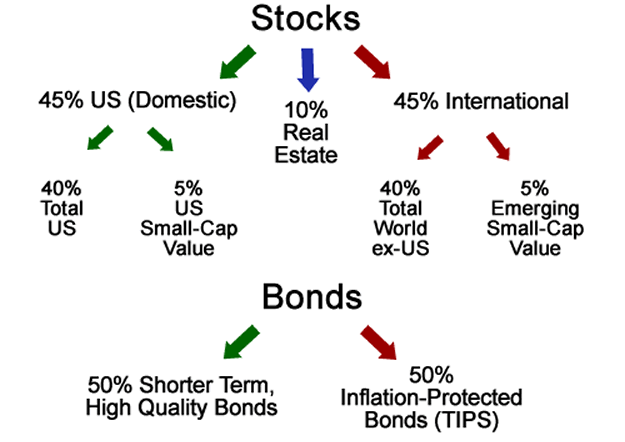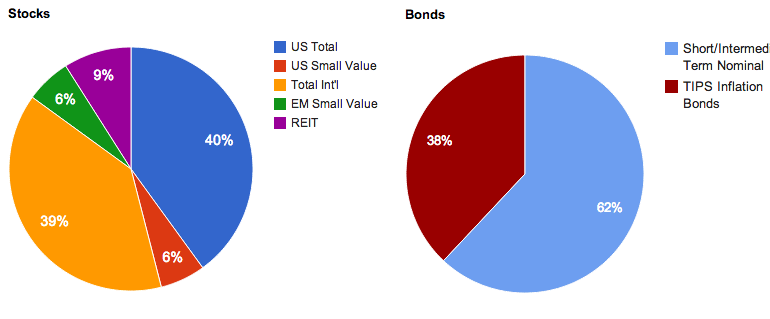Here’s a 2013 year-end update of our retirement portfolio, which includes employer 401(k) plans, self-employed retirement plans, Traditional and Roth IRAs, and taxable brokerage holdings. Cash reserves (emergency fund), college savings accounts, experimental portfolios, and day-to-day cash balances are excluded. The purpose of this portfolio is to eventually create enough income on its own to cover all daily expenses.
Target Asset Allocation
This has been mostly the same for over 6 years, although I did make some slight tweaks in my last June 2013 update.

I try to pick asset classes that are likely to provide a long-term return above inflation, as well as offer some historical tendencies to be less correlated to each other. I don’t hold commodities futures or gold because theoretically their prices should only match inflation. In addition, I am not confident in them enough to know that I will hold them through an extended period of underperformance (and if you don’t do that, there’s no point). 2013 turned out to be a tough year for both gold and commodities funds.
Our current ratio is about 70% stocks and 30% bonds within our investment strategy of buy, hold, and rebalance. With low expense ratios and low turnover, we minimize our costs in terms of paying fees, commissions, and taxes.
Actual Holdings
Here is our year-end asset allocation snapshot:

Stock Holdings (Ticker Symbol)
Vanguard Total Stock Market Fund (VTI, VTSMX, VTSAX)
Vanguard Total International Stock Market Fund (VXUS, VGTSX, VTIAX)
WisdomTree SmallCap Dividend ETF (DES)
WisdomTree Emerging Markets SmallCap Dividend ETF (DGS)
Vanguard REIT Index Fund (VNQ, VGSIX, VGSLX)
Bond Holdings
Vanguard Limited-Term Tax-Exempt Fund (VMLTX, VMLUX)
Vanguard High-Yield Tax-Exempt Fund (VWAHX, VWALX)
PIMCO Total Return Institutional* (PTTRX)
Stable Value Fund* (2.6% yield, net of fees)
iShares Barclays TIPS Bond ETF (TIP)
Individual TIPS securities
US Savings Bonds
The holdings haven’t changed through the latter half of this year, just some additional purchases of existing funds.
In terms of performance, in general stocks had a great year while bonds pretty much went nowhere or slightly down. I don’t expect everything to go up every year, not to mention my portfolio is bigger than I could have expected just a few years ago, so I can’t complain. Here are some 2013 YTD total returns for selected representative funds as of 12/27/13:
Stocks
Total US VTI +33%
Total International VXUS +14%
US Small Cap Value DES +37%
Emerging Market Small Cap Value DGS -5%
US REITs VNQ +3%
Bonds
Short-term Muni VMLUX +0.5%
Intermediate-term Muni VWALX -3%
Inflation-protected bonds -9%
 The Best Credit Card Bonus Offers – 2025
The Best Credit Card Bonus Offers – 2025 Big List of Free Stocks from Brokerage Apps
Big List of Free Stocks from Brokerage Apps Best Interest Rates on Cash - 2025
Best Interest Rates on Cash - 2025 Free Credit Scores x 3 + Free Credit Monitoring
Free Credit Scores x 3 + Free Credit Monitoring Best No Fee 0% APR Balance Transfer Offers
Best No Fee 0% APR Balance Transfer Offers Little-Known Cellular Data Plans That Can Save Big Money
Little-Known Cellular Data Plans That Can Save Big Money How To Haggle Your Cable or Direct TV Bill
How To Haggle Your Cable or Direct TV Bill Big List of Free Consumer Data Reports (Credit, Rent, Work)
Big List of Free Consumer Data Reports (Credit, Rent, Work)
So here’s the dilemma. A good bogle-heads, we’re taught not to try and time the market but with interest rates with no where to go but up, how can bond market funds be a buy? Even to re-balance? Will you be selling off your US stocks to rebalance bonds?
That takes some grit.
Yeah, I’ve been facing the same dilemma. I’d like to reduce my exposure to equities somewhat, but I cannot fathom rebalancing into investment-grade debt instruments.
I’ve been hedging my position by putting my normal desired fixed income portion into High-Yield bonds (e.g., JNK), which seems to have about 50% of the volatility and correlate well with the equities market. As treasury yields creep higher, I’ll consider taking some of that allocation and shifting it towards higher credit quality.
I also have a position in a Municipal Bond closed-end fund (NRK) that uses some leverage to boost yields. Returns about 6.5-7%, and bought in when it had about a 10% discount to NAV. Last year faced a brutal selloff, but considering 10-year treasuries were about 1.6%, and now at 3%, where many people I’ve talked with expect to see about 10-years reach about 3.5% this year, it’s levelled off nicely. Plus, the tax-free, AMT-free income is great!
For the bond component of my allocations, I use actively managed mutual funds (PIMCO, TCW, Metropolitan West, Loomis Sayles, DoubleLine and Templeton) rather than ETFs. I’d like to think they will add value in excess of their fees. Time will tell.
I still think in today’s market bonds are a bad buy… most of what is said here is still true…. Once the feed announces they are going to unload their bonds it seems like yields and prices for bonds will get much more attractive…
http://bonds.about.com/b/2013/05/07/warren-buffett-bonds-are-a-terrible-investment-right-now.htm
I’m not convinced that the conventional wisdom that gold is somehow a hedge against inflation. It seems, more likely, it’s an instrument that’s capable of taking into consideration future inflation expectations, but can be a highly volatile asset.
When I first took a look at gold, I noticed how it reacted around 1980-1981, during the Savings and Loans crisis. Prices went parabolic, and suffered a very swift and dramatic decline, where a new, relatively stable floor was set for about 20 years.
I’m not convinced that the selloff in gold is over, as this last crisis may have represented another case where inflation fears didn’t materialise. I personally won’t be accumulating gold in my portfolio until prices drop below $1,000/oz, and won’t consider a significant portion unless it reaches $600/oz or lower, or there’s evidence that a long-term, stable price floor has been formed once again.
For all of you looking at current HQ bond yields and letting that drive your asset allocation decisions, you’re missing the point and not understanding the role of fixed income in a well-diversified portfolio. And that’s a recipe for trouble! You need to think in terms of total portfolio return, not what the individual pieces, i.e asset classes, are returning. You don’t own Treasury bonds for income or growth, but rather for portfolio ballast and stability. The stocks are what give you the growth over time. Who cares if you lost 3-4% this year with you fixed income? What you earned on the stock side more than makes that small loss irrelevant. It’s all about determining how much risk is appropriate for your situation, and having the discipline to stick to it when your emotions are suggesting you otherwise. Never forget 2008, and the one asset class that made money that year: Treasurys. THAT is why you must always own them.
Besides, if interest rates are going up, that’s probably Mr. Market telling you the economy is improving, which likely which result in a rising stock market. Fixed income yield will recover over time, and the extra interest you’ll earn will compensate for any ST loss to principal.
For those of you who can’t get past your rising interest rate risk fears, consider shortening your duration to 3 to 5 years, easily done by combining ST and IT treasury funds or ETF’s. And don’t forget TIPS too.
Jonathan,
How did you convince yourself the wisdom tree funds were a good alternative to Vanguard (Or to other low cost index funds)?
I’m trying to convince myself but I’m still a bit doubtful DES is really a better alternative to VBR.
Thanks ,
-Ben
I’m not really convinced they are “better”, more that they are just different. I talked more about the DES decision in my June 2013 portfolio update post:
https://www.mymoneyblog.com/retirement-portfolio-update-1306.html
Everyone has a unique diversification portfolio to fit their needs. I’m comfortable enough with what I’ve come up with to share it here. I’m also uncertain enough, to want feedback on it, so to the readers of this board, please, critique it.
My goal is 5-7% average annual return over the next 8-10 years.
I have a rather odd defined retirement benefit from my current employer that says in 11 years, if 50% of contributions to my 403b are to a TIAA annuity, and 50% into the CREF stock fund, I’m guaranteed 50% of the average of my last 3 years salary at retirement. The annuity has a guarantee (based off of TIAA-CREF’s ability to pay) of a minimum 3% return, current contributions get %3.75, and my total contributions to this account are returning ~4%. This complicates things a bit. I only mention it to justify the large fixed income stake in an annuity.
One other constraint is that I have a funds in 3 different accounts, due to different employers and simply leaving my investments in their plans. I could combine them, but haven’t seen a good value in return for the effort it would take.
I rebalance in September, January and May. Here is what I just rebalanced to:
33% fixed income
30% US stocks
18% Foreign Developed Markets
7% Emerging Markets
12% Real Estate.
I break these down as follows:
33% fixed income
50% Annuity (TIAA)
10% Short Term (VBITX,CMMA)
10% Intermediate Term (PTTRX,CBND)
20% TIPS (VIPIX,PRRIX,CILB)
5% High Yield (TIHRX, NRHIX)
5% Foreign (PFUIX,TPINX)
30% US stocks
6% Dividend Growth (VDIGX)
24% Large Cap (VINIX,FXSIX,CSTK)
20% Large Cap Growth (TRGIX,CGRW,FCNKX,HACAX)
15% Mid Cap (VMCIX,TRVRX)
15% Mid Cap Growth (MERDX)
10% Small Cap (FSEVX)
10% Small Cap Growth (VSCIX)
18% Foreign Developed Markets (CGLB,HIAOX,RERGX,TRIEX)
7% Emerging Markets (VEMIX,ABEMX,DFEVX)
12% Real Estate
66% Pooled (TREA,TP9R)
33% REIT (CSRIX,TRRSX)
Your thoughts?
Shoot, my tabs got lost in the translation. Please insert blank lines near the bottom before:
30% US stocks, 18% Foreign Developed Markets (CGLB,HIAOX,RERGX,TRIEX), 7% Emerging Markets (VEMIX,ABEMX,DFEVX), 12% Real Estate